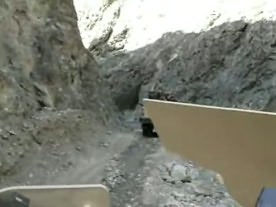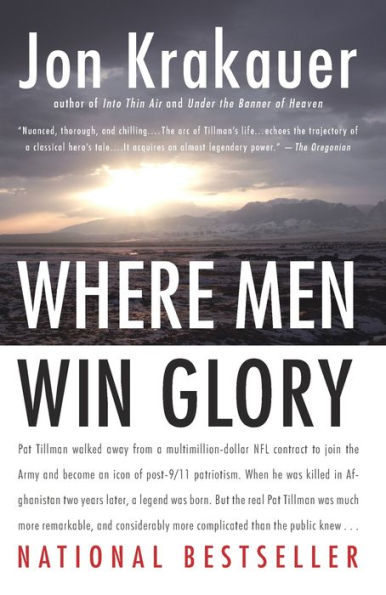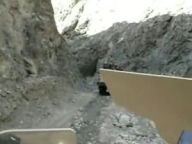The author of “Into Thin Air” and “Under the Banner of Heaven” looks at a national problem through one city’s history of sexual violence. Review by Melissa Holbrooke Pierson.
NATIONAL BESTSELLER • A "gripping book about this extraordinary man who lived passionately and died unnecessarily" (USA Today) in post-9/11 Afghanistan, from the bestselling author of Into the Wild and Into Thin Air.
In 2002, Pat Tillman walked away from a multimillion-dollar NFL contract to join the Army and became an icon of American patriotism. When he was killed in Afghanistan two years later, a legend was born. But the real Pat Tillman was much more remarkable, and considerably more complicated than the public knew.
Sent first to Iraq—a war he would openly declare was “illegal as hell” —and eventually to Afghanistan, Tillman was driven by emotionally charged, sometimes contradictory notions of duty, honor, justice, and masculine pride, and he was determined to serve his entire three-year commitment. But on April 22, 2004, his life would end in a barrage of bullets fired by his fellow soldiers. Though obvious to most of the two dozen soldiers on the scene that a ranger in Tillman’s own platoon had fired the fatal shots, the Army aggressively maneuvered to keep this information from Tillman’s family and the American public for five weeks following his death. During this time, President Bush used Tillman’s name to promote his administration’ s foreign policy. Long after Tillman’s nationally televised memorial service, the Army grudgingly notified his closest relatives that he had “probably” been killed by friendly fire while it continued to dissemble about the details of his death and who was responsible.
Drawing on Tillman’s journals and letters and countless interviews with those who knew him and extensive research in Afghanistan, Jon Krakauer chronicles Tillman’s riveting, tragic odyssey in engrossing detail highlighting his remarkable character and personality while closely examining the murky, heartbreaking circumstances of his death. Infused with the power and authenticity readers have come to expect from Krakauer’s storytelling, Where Men Win Glory exposes shattering truths about men and war.
This edition has been updated to reflect new developments and includes new material obtained through the Freedom of Information Act.
1100380955
In 2002, Pat Tillman walked away from a multimillion-dollar NFL contract to join the Army and became an icon of American patriotism. When he was killed in Afghanistan two years later, a legend was born. But the real Pat Tillman was much more remarkable, and considerably more complicated than the public knew.
Sent first to Iraq—a war he would openly declare was “illegal as hell” —and eventually to Afghanistan, Tillman was driven by emotionally charged, sometimes contradictory notions of duty, honor, justice, and masculine pride, and he was determined to serve his entire three-year commitment. But on April 22, 2004, his life would end in a barrage of bullets fired by his fellow soldiers. Though obvious to most of the two dozen soldiers on the scene that a ranger in Tillman’s own platoon had fired the fatal shots, the Army aggressively maneuvered to keep this information from Tillman’s family and the American public for five weeks following his death. During this time, President Bush used Tillman’s name to promote his administration’ s foreign policy. Long after Tillman’s nationally televised memorial service, the Army grudgingly notified his closest relatives that he had “probably” been killed by friendly fire while it continued to dissemble about the details of his death and who was responsible.
Drawing on Tillman’s journals and letters and countless interviews with those who knew him and extensive research in Afghanistan, Jon Krakauer chronicles Tillman’s riveting, tragic odyssey in engrossing detail highlighting his remarkable character and personality while closely examining the murky, heartbreaking circumstances of his death. Infused with the power and authenticity readers have come to expect from Krakauer’s storytelling, Where Men Win Glory exposes shattering truths about men and war.
This edition has been updated to reflect new developments and includes new material obtained through the Freedom of Information Act.
Where Men Win Glory: The Odyssey of Pat Tillman
NATIONAL BESTSELLER • A "gripping book about this extraordinary man who lived passionately and died unnecessarily" (USA Today) in post-9/11 Afghanistan, from the bestselling author of Into the Wild and Into Thin Air.
In 2002, Pat Tillman walked away from a multimillion-dollar NFL contract to join the Army and became an icon of American patriotism. When he was killed in Afghanistan two years later, a legend was born. But the real Pat Tillman was much more remarkable, and considerably more complicated than the public knew.
Sent first to Iraq—a war he would openly declare was “illegal as hell” —and eventually to Afghanistan, Tillman was driven by emotionally charged, sometimes contradictory notions of duty, honor, justice, and masculine pride, and he was determined to serve his entire three-year commitment. But on April 22, 2004, his life would end in a barrage of bullets fired by his fellow soldiers. Though obvious to most of the two dozen soldiers on the scene that a ranger in Tillman’s own platoon had fired the fatal shots, the Army aggressively maneuvered to keep this information from Tillman’s family and the American public for five weeks following his death. During this time, President Bush used Tillman’s name to promote his administration’ s foreign policy. Long after Tillman’s nationally televised memorial service, the Army grudgingly notified his closest relatives that he had “probably” been killed by friendly fire while it continued to dissemble about the details of his death and who was responsible.
Drawing on Tillman’s journals and letters and countless interviews with those who knew him and extensive research in Afghanistan, Jon Krakauer chronicles Tillman’s riveting, tragic odyssey in engrossing detail highlighting his remarkable character and personality while closely examining the murky, heartbreaking circumstances of his death. Infused with the power and authenticity readers have come to expect from Krakauer’s storytelling, Where Men Win Glory exposes shattering truths about men and war.
This edition has been updated to reflect new developments and includes new material obtained through the Freedom of Information Act.
In 2002, Pat Tillman walked away from a multimillion-dollar NFL contract to join the Army and became an icon of American patriotism. When he was killed in Afghanistan two years later, a legend was born. But the real Pat Tillman was much more remarkable, and considerably more complicated than the public knew.
Sent first to Iraq—a war he would openly declare was “illegal as hell” —and eventually to Afghanistan, Tillman was driven by emotionally charged, sometimes contradictory notions of duty, honor, justice, and masculine pride, and he was determined to serve his entire three-year commitment. But on April 22, 2004, his life would end in a barrage of bullets fired by his fellow soldiers. Though obvious to most of the two dozen soldiers on the scene that a ranger in Tillman’s own platoon had fired the fatal shots, the Army aggressively maneuvered to keep this information from Tillman’s family and the American public for five weeks following his death. During this time, President Bush used Tillman’s name to promote his administration’ s foreign policy. Long after Tillman’s nationally televised memorial service, the Army grudgingly notified his closest relatives that he had “probably” been killed by friendly fire while it continued to dissemble about the details of his death and who was responsible.
Drawing on Tillman’s journals and letters and countless interviews with those who knew him and extensive research in Afghanistan, Jon Krakauer chronicles Tillman’s riveting, tragic odyssey in engrossing detail highlighting his remarkable character and personality while closely examining the murky, heartbreaking circumstances of his death. Infused with the power and authenticity readers have come to expect from Krakauer’s storytelling, Where Men Win Glory exposes shattering truths about men and war.
This edition has been updated to reflect new developments and includes new material obtained through the Freedom of Information Act.
19.0
In Stock
5
1

Where Men Win Glory: The Odyssey of Pat Tillman
480
Where Men Win Glory: The Odyssey of Pat Tillman
480
19.0
In Stock

Product Details
| ISBN-13: | 9780307386045 |
|---|---|
| Publisher: | Knopf Doubleday Publishing Group |
| Publication date: | 07/27/2010 |
| Pages: | 480 |
| Sales rank: | 20,464 |
| Product dimensions: | 6.16(w) x 11.08(h) x 1.06(d) |
| Lexile: | 1300L (what's this?) |
About the Author
From the B&N Reads Blog
Videos


